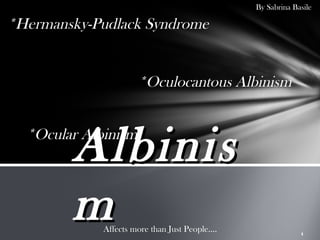
Albinism powerpoint[1]
- 1. By Sabrina Basile *Hermansky-Pudlack Syndrome *Oculocantous Albinism Albinis *Ocular Albinism m Affects more than Just People…. 1
- 2. ✴Despite the claims of earlier Y historians, Aulus Gellius and Plinius Secundus the Elder , that are said to first have observed albinism, its discovery as a disease was credited to Archibald Garrod. The disease was discovered by Garrod in roughly 1908. He observed patients, particularly those with symptoms like hypersensitivity to light, and eye misalignment. 2
- 3. What is Hermanskey- Pudlack Syndrome? ✴ Hermansky-Pudlak syndrome is characterized by a condition called oculocutaneous albinism, which causes an abnormal light coloring pigmentation of the skin, hair, and eyes. ✴ Those affected by the syndrome, have fair skin and either white or light colored hair. ✴ Excessive sun exposure increases the risk of skin damage or cancer What is Oculocutaneous Albinism? ✴ Disorder in which pigmentation in the iris (colored part of your eye) and the light-sensitive tissue in the back of your eye (Retina) is reduced. 3
- 4. ✴At least eight genes are associated with albinism. These genes Gene Mutation...... provide instructions for making proteins that are used to make four distinct protein complexes. The complexes are used to construct a group of cells called lysosome-related organelles (LROs). ✴LORs perform specialized functions found in certain cells. ✴They have been identified in pigment cells ✴Mutations in genes associated with albinism prevent the formation of LORs or impair the functioning of the structure. ✴People who have the disease prevent LROs within Pigment cells to produce and distribute the substance that gives skin, hair, and eyes their color
- 5. Inhe ritan ce.. ... The condition is inherited in an autosomal recessive pattern, which means both copies of the gene in each cell have mutations. The parents of an individual with an autosomal recessive condition each carry one copy of the mutated gene, but they typically do not show signs and symptoms of the condition.
- 6. Two Types of Causes. …. Type 1- Albinism is caused by defects that affect production of the pigment, melanin. Type 2; Albinism is due to a defect in the "P" gene. People with this type have slight coloring at birth. 6
- 7. Pedigree Example for Albinism… The pedigree above is an example of how individuals can inherit albinism. All the shapes not shaded may not have expressed the disease, but they all inherited the gene. This is evident in the fourth generation; 4 of the children express the disease.
- 8. How can Albinism be Diagnosed? ✴Doctors may diagnose the condition based on the appearance of your skin, hair, and eyes. -An ophthalmologist should further test a patient to reveal vision problems related to albinism ✴Genetic testing offers the most accurate way to diagnose albinism. *Ophthalmologist; A doctor specializing in the medical science dealing with the anatomy, functions, and diseases of the eye.
- 9. A person with albinism will have one of the following symptoms: Absence of color in the hair, skin, or iris of the eye Lighter than normal skin and hair Patchy, missing skin color Many forms of albinism are associated with the following symptoms: Crossed eyes (strabismus) Light sensitivity (photophobia) Rapid eye movements (nystagmus) s Vision problems, or functional blindness Problems with blood clotting Some experience breathing problems due to a lung disease called Pulmonary 9
- 10. Treatment There is no real cure for albinism, but the goal of treatment is to relieve symptoms Treatment involves protecting the skin and eyes from the sun: Reduce sunburn risk by avoiding the sun, u using sunscreen, and covering up completely with clothing when exposed to the sun. Sunscreen should have a high SPF Sunglasses may relieve light sensitivity. Glasses are often prescribed to correct vision problems and eye position. Eye muscle surgery is sometimes recommended to correct abnormal eye movements. 10
- 11. How Common is the Disease? Albinism is a rare disorder in most populations; but it is estimated to affect 1 in 500,000 to 1 in 1,000,000 individuals worldwide. Seems to be more common in Puerto Rico where 1 in 1,800 can be affected. Groups in Japan and Switzerland have also been found to be affected
- 12. National Organization for Albinism and Hypopigmentation -- www.albinism.org Groups… International Albinism Center -- www.med.umn.edu/ophthalmology/ce nters/albinism/home.html Hermansky-Pudlak Syndrome Network -- www.hpsnetwork.org 12